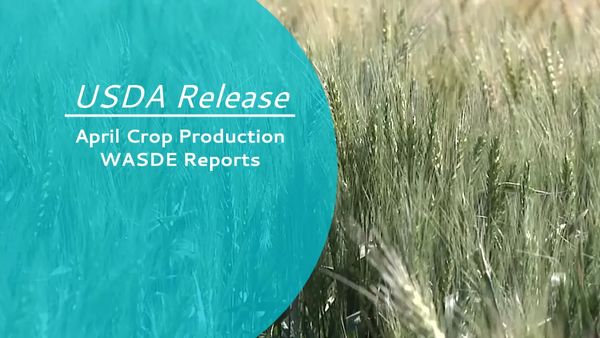.png?fit=outside&w=1280&h=720)
Few Changes in USDA Reports
April 11, 2023
In a report with few changes to U.S. corn and soybean numbers, USDA lowered Argentina's corn production 3 million metric tons (mmt) to 37 mmt, but held pat on Brazil's production, at 125 mmt, despite expectations that Brazil's production is higher.
According to DTN Lead Analyst Todd Hultman, Tuesday's U.S. ending stocks estimates were neutral for corn and soybeans, and slightly bearish for wheat. Hultman sees the world ending stocks estimates from USDA as roughly neutral for corn, soybeans and wheat.
USDA on Tuesday released its April Crop Production and World Agricultural Supply and Demand Estimates (WASDE) reports.
Stay tuned throughout the morning and refresh this page often as we will be sending a series of updates with the important highlights from today's reports, including commentary from our analysts.
WHEAT
USDA increased U.S. wheat ending stocks for the 2022-2023 season to 598 mb, exceeding analysts' pre-report estimates of 581 mb. It is the lowest ending-stocks number in nine years.
Average wheat farm gate price was estimated at $8.90 per bushel, a drop from $9.00 last month.
Globally, old-crop wheat ending stocks were projected at 265.05 mmt down from 267.20 mmt in the March estimate.
In South America, USDA estimates Argentina's ending stocks at 2.53 mmt. That's a slight decrease from 2.51 mmt in March. Brazil's ending stocks are estimated at 1.78 mmt, an increase from 1.08 mmt in March.
Ukrainian ending stocks are estimated at 3.34 mmt, a decrease from 4.17 mmt in the March estimates. Russian ending stocks are left unchanged at 14.39 mmt.
USDA estimates Ukraine's exports at 14.50 mmt, an increase from 13.50 mmt in March. Russian exports are estimated at 45.0 mmt, an increase from 43.50 mmt in March.
CORN
USDA made few changes to the corn supply and demand in the 2022-23 corn crop. Ending stocks held pat at 1.342 billion bushels (bb), despite pre-report estimates that USDA would bring down ending stocks.
Export demand was pegged 1.85 bb, the same as March, another surprise.
Imports were lowered 10 million bushels (mb) to 40 mb Total supply was lowered a corresponding 10 mb to 15.147 bb.
Feed and Residual use was reported 5.275 bb. Yet, Food, Seed and Industrial use was lowered 10 mb to 6.68 bb. Ethanol use was held pat at 5.25 bb. Total domestic use came in at 11.955 bb.
Total use came in at 13.805 bb.
The farmgate price was pegged at $6.60 a bushel, the same as March.
Globally, beginning stocks for corn in the 2022-23 crop were increased 1.22 mmt to 306.91 mmt. Total production was lowered 3.02 mmt estimated at 1,144.50. Global ending stocks for 2022-23 were lowered 1.11 mmt to 295.35 mmt.
Brazil's production held pat at 125 mmt for 2022-23 and exports were pegged at 50 mmt, the same as March. Argentina production was lowered 3 mmt to 37 mmt and Argentina's exports were also lowered 3 mmt to 25 mmt as well. Ukraine's production held firm at 27 mmt and Ukraine's exports held pat at 23.5 mmt.
SOYBEANS
USDA left soybean ending stocks for 2022-23 unchanged at 210 mb. Traders anticipated USDA would lower its estimate following last month's Grain Stocks report. USDA made no changes to soybean's demand categories, leaving exports at 2.015 bb and crush at 2.22 bb. The national average farm gate price was also unchanged at $14.30 per bushel.
Global ending stocks increased by .28 mmt to 100.29 mmt. USDA lowered global soybean production by 5.5 mmt, but also reduced its crush estimates, resulting in very little adjustment to the overall stocks figure. USDA increased its forecast for Brazilian soybean production by 1 mmt to 154 mmt, while slashing Argentina's output to 27 mmt from 33 mmt.
LIVESTOCK
Tuesday's WASDE report treated the beef and cattle markets mostly favorably. Beef production for 2023 was raised by 110 million pounds, with the second and third quarters of 2023 both seeing increases in beef production while the first and fourth quarters were decreased. The first quarter of 2023 saw a slight price decrease from last month's report, down $0.10 to average $160.90, but the rest of the quarters for the year saw price increases. The second quarter of 2023 is expected to average $169.00 which is $6.00 higher from last month, the third quarter is expected to average $162.00, which is $3.00 higher from last month, and the fourth quarter is expected to average $167.00, which is $3.00 higher than last month. 2023 beef imports were raised by 75 million pounds, but exports for the year also grew by 45 million pounds as demand from Asia countries remains incredibly strong.
Mostly Tuesday's WASDE report wasn't the news that the pork and hog markets wanted to see. Pork production for 2023 was decreased by 50 million pounds as the latest Hogs and Pigs report highlighted that the December-February pig crop and producer farrowing intentions for March-May were lower than originally expected. The quarterly price projections for barrow and gilt prices were a bitter pill to swallow in Tuesday's report as all four quarters saw price reductions from a month ago as the USDA accounted for the light/modest demand in which pork cuts have been receiving. The first quarter was reduced by $1.17 to average $54.83, the second quarter fell $10 from last month to average $60.00, the third quarter fell by $6.00 to average $67.00 and the fourth quarter fell by $2.00 to average $62.00. Pork imports for 2023 grew by 60 million pounds from last month, but pork exports also grew by 30 million pounds.
-- Crop Production: https://www.nass.usda.gov/…
-- World Agricultural Supply and Demand Estimates (WASDE): http://www.usda.gov/oce/commodity/wasde/
Source: DTN










